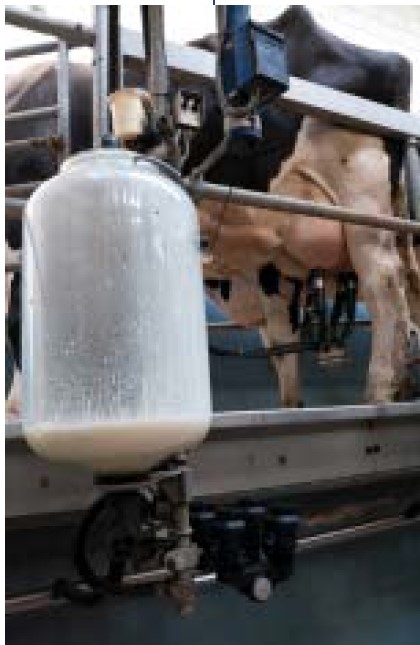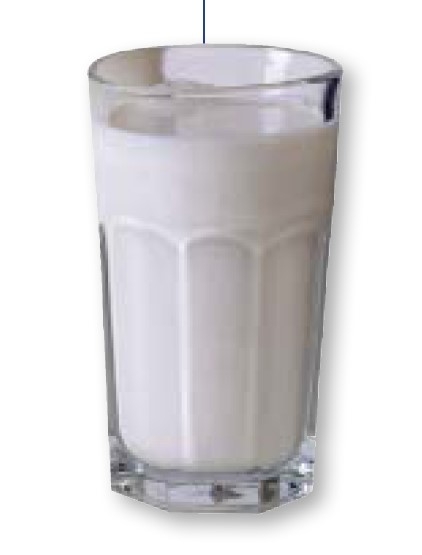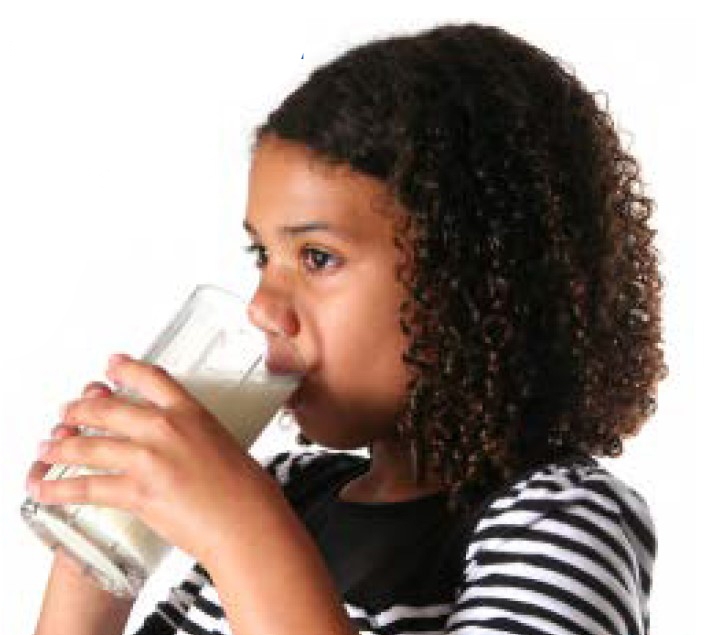IMPORTANT FACTS About the Safety of Unpasteurized (Raw) Milk
ID
FST-139P (FST-331P)

The majority of the milk and dairy products sold in the United States are pasteurized, which means they go through a heat process that kills harmful bacteria (e.g., Salmonella, E. coli, Campylobacter, etc.) that can be found in unpasteurized (raw) milk. Pasteurization not only improves the safety of the milk but also lengthens its shelf life.
Only a small percentage of Americans report that they have consumed raw milk. While uncommon, the consumption of raw milk carries significant health risks, and consumers should be aware of those risks. Although healthy people of any age can get very sick or even die if they consume contaminated raw milk, the risk is greater for certain populations, including young children, pregnant women, the elderly, and people with weakened immune systems.

How Raw Milk Becomes Contaminated
Raw milk can become contaminated with bacteria during milking as well as during handling, storage, and transport of milk. Bacteria that cause human illness, such as Salmonella, E. coli, Campylobacter, Listeria, Coxiella burnetii, Staphylococcus, and Streptococcus, can be found in the cow’s udder area, even in healthy cows. These bacteria can also be found in the farm environment, on equipment and workers’ hands, etc. Milk is an excellent growth medium for bacteria, and if even a very small amount of contamination occurs, bacteria can grow rapidly.
Sanitation Helps but Doesn’t Eliminate the Risk
Adhering to good milking hygiene practices and keeping the herd healthy can reduce the potential for milk to become contaminated. Additionally, holding the milk at temperatures lower than 45 degrees Fahrenheit after milking helps slow the growth of bacteria that may be present. However, cross contamination during storage and transport can play a significant role in contamination; therefore, following sanitary practices during every step of the milking process is critical. Even under ideal conditions of cleanliness, the process of collecting milk can introduce bacteria. Unless the milk is pasteurized, bacteria introduced can multiply and grow in the milk and cause illness.
Sale of Pasteurized and Unpasteurized Milk in the U.S.
The U.S. Food and Drug Administration (FDA) mandates that all fluid milk for human consumption that enters interstate commerce be pasteurized. The FDA has developed the Grade “A” Pasteurized Milk Ordinance to be used by states in regulating fluid milk products (FDA 2017). This model ordinance that has been adopted as regulation by all 50 states addresses the production and sale of fluid milk that will enter interstate commerce. Because the FDA has no jurisdiction over the sale of milk within state borders, it’s up to each state to establish regulations for the sale and enforcement of Grade A and unpasteurized milk intended for human consumption within their borders.
Sale of Unpasteurized (Raw) Milk in Virginia
The sale of unpasteurized fluid milk and unpasteurized dairy-based products, including non-aged unpasteurized cheese, violates existing Virginia regulations. Aged cheeses made with unpasteurized milk and manufactured in a facility regulated and inspected by the Virginia Department of Agriculture and Consumer Services Dairy Services Program can enter intrastate and interstate commerce and are considered safe for consumption as long as the cheese has been aged for a minimum of 60 days (Richard Wilkes, state veterinarian, Virginia Department of Agriculture and Consumer Services, personal communication, Dec. 4, 2013).
Outbreaks Caused by Consumption of Milk and Dairy Products
Despite advances in pasteurization of milk and milk products, dairyassociated disease outbreaks continue to occur. Between 1993 - 2012, there were 127 outbreaks linked to raw milk. These outbreaks resulted in 1,909 illnesses and 144 hospitalizations (CDC, 2017). According to a study examining outbreaks between 1993 and 2006, the majority of outbreaks (77 percent) involving raw milk dairy products occurred in states where the sale of the products was legal at the time (Langer et al. 2012). States restricting the sale of raw milk dairy products had fewer outbreaks and illnesses.
In 2006, nine children in Virginia became ill with an outbreak caused by Campylobacter that was linked to consumption of raw milk (Seth Levine, senior epidemiologist, Virginia Department of Health, email communication, Nov. 14, 2013). It is estimated that no more than 1 percent of the milk consumed in the U.S. is raw, however according to the Centers for Disease Control and Prevention, the number of outbreaks caused by raw milk is at least 150 times greater than the number of outbreaks caused by pasteurized milk (Langer et al. 2012). For these reasons, the FDA, CDC, American Veterinary Medical Association, university cooperative extension programs, and many other organizations recommend that all fluid milk consumed by people be pasteurized.
Illnesses Caused by Consuming Raw Milk
Symptoms of illness caused by consuming raw milk or foods made with raw milk depend on the type of bacterium that contaminated the milk. Often symptoms include vomiting, diarrhea, abdominal pain, fever, headache, and body ache. Most healthy people will recover from illnesses caused by consuming raw milk; however, in some populations — including infants, young children, the elderly, and those with weakened immune systems — symptoms can be more severe or even life-threatening.
Effect of Pasteurization on the Nutrient Content of Milk
Scientific literature shows that milk nutrients (including vitamins and milk proteins) are unchanged by common pasteurization processes (LeJeune and Rajala-Schultz 2009). There is also no scientific evidence that unpasteurized milk can be used to prevent or treat disease.
Additional Resources
Centers for Disease Control and Prevention. 2017. “Food Safety and Raw Milk.” Website. https://www.cdc.gov/ foodsafety/rawmilk/raw-milk-index.html.
U.S. Food and Drug Administration. 2011. “Questions and Answers: Raw Milk.” FDA Website. https://www.fda.gov/food/buystore-serve-safe-food/raw-milk-questionsanswers.
References
CDC (Centers for Disease Control and Prevention). 2017. “Raw Milk Questions and Answers.” CDC Website. https://www.cdc.gov/foodsafety/rawmilk/raw-milk-questions-and-answers.html.
FDA (U.S. Food and Drug Administration). 2017. Grade “A” Pasteurized Milk Ordinance.U.S. Health and Human Services, U.S. Public Health Service. Rev. 2017. https://www.fda.gov/media/114169/download.
Langer, A. J., T. Ayers, J. Grass, M. Lynch, F. J. Angulo, and B. E. Mahon. 2012. “Nonpasteurized Dairy Products, Disease Outbreaks, and State Laws – United States, 1993-2006.” Online Journal. Emerging Infectious Diseases 18 (3). wwwnc.cdc.gov/eid/article/18/3/11-1370_article.htm.
Lejeune, J. T., and P. J. Rajala-Schultz. 2009. “Unpasteurized Milk: A Continued Public Health Threat.” Clinical Infectious Diseases 48 (1): 93-100.

Virginia Cooperative Extension materials are available for public use, reprint, or citation without further permission, provided the use includes credit to the author and to Virginia Cooperative Extension, Virginia Tech, and Virginia State University.
Virginia Cooperative Extension is a partnership of Virginia Tech, Virginia State University, the U.S. Department of Agriculture, and local governments. Its programs and employment are open to all, regardless of age, color, disability, sex (including pregnancy), gender, gender identity, gender expression, national origin, political affiliation, race, religion, sexual orientation, genetic information, military status, or any other basis protected by law
Publication Date
October 1, 2019



